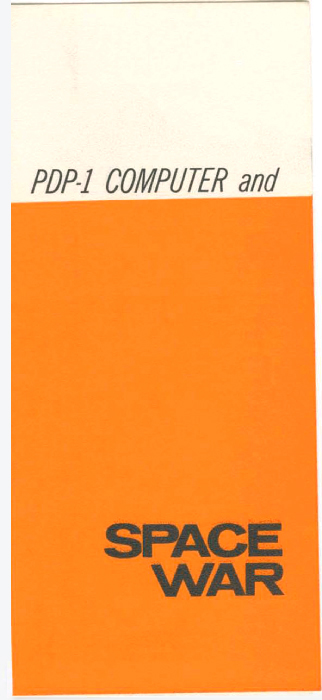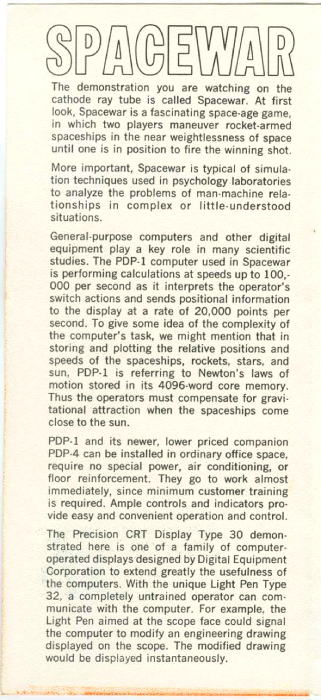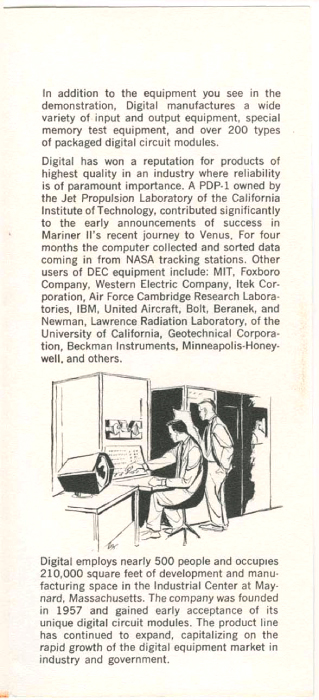“PDP-1 Computer and Spacewar”
This is a promotional brochure by the Digital Equipment Corporation (DEC) celebrating Spacewar!, 1963 ca.
The brochure also illustrates the ambiguous position on Spacewar!: While the game was officially banned at some installations (e.g. BBN outlawed Spacewar! occasionally, mainly because of dying control switches), it was also the most important showcase for the PDP-1. Eventually PDP-1s shipped with a copy of Spacewar! in memory for testing purpose. (Since the machine's magnetic core memory was persistent, the program would be present, when the machine was unpacked and switched on — ready for a test run of Spacewar! This wasn't an outrageous claim at all, since the program utilized nearly every resource of the machine.)




Transcript:
PDP-1 COMPUTER and
SPACE
WAR
p. 2
SPACEWAR
The demonstration you are watching on the cathode ray tube is called Spacewar. At first look, Spacewar is a fascinating space-age game, in which two players maneuver rocket-armed spaceships in the near weightlessness of space until one is in position to fire the winning shot.
More important, Spacewar is typical of simulation techniques used in psychology laboratories to analyze the problems of man-machine relationships in complex or little-understood situations.
General-purpose computers and other digital equipment play a key role in many scientific studies. The PDP-1 computer used in Spacewar is performing calculations at speeds up to 100,000 per second as it interprets the operator's switch actions and sends positional information to the display at a rate of 20,000 points per second. To give some idea of the complexity of the computer's task, we might mention that in storing and plotting the relative positions and speeds of the spaceships, rockets, stars, and sun, PDP-1 is referring to Newton's laws of motion stored in its 4096-word core memory. Thus the operators must compensate for gravitational attraction when the spaceships come close to the sun.
PDP-1 and its newer, lower priced companion PDP-4 can be installed in ordinary office space, require no special power, air conditioning, or floor reinforcement. They go to work almost immediately, since minimum customer training is required. Ample controls and indicators provide easy and convenient operation and control.
The Precision CRT Display Type 30 demonstrated here is one of the family of computer-operated displays designed by Digital Equipment Corporation to extend greatly the usefulness of the computers. With the unique Light Pen Type 32, a completely untrained operator can communicate with the computer. For example, the Light Pen aimed at the scope face could signal the computer to modify an engineering drawing displayed at the scope. The modified drawing would be displayed instantaneously.
p. 3In addition to the equipment you see in the demonstration, Digital manufactures a wide variety of input and output equipment, special memory test equipment, and over 200 types of packaged digital circuit modules.
Digital has won a reputation for products of highest quality in an industry where reliability is of paramount importance. A PDP-1 owned by the Jet Propulsion Laboratory of the California Institute of Technology, contributed significantly to the early announcements of success in Mariner II's recent journey to Venus. For four months the computer collected and sorted data coming in from NASA tracking stations. Other users of DEC equipment include: MIT, Foxboro Company, Western Electric Company, Itek Corporation, Air Force Cambridge Research Laboratories, IBM, United Aircraft, Bolt, Beranek, and Newman, Lawrence Radiation Laboratory, of the University of California, Geotechnical Corporation, Beckman Instruments, Minneapolis-Honeywell, and others.
[Illustration: PDP-1 and operators.]
Digital employs nearly 500 people and occupies 210,000 square feet of development and manu- facturing space in the Industrial Center at Maynard, Massachusetts. The company was founded in 1957 and gained early acceptance of its unique digital circuit modules. The product line has continued to expand, capitalizing on the rapid growth of the digital equipment market in industry and government.
p. 4digital
EQUIPMENT
CORPORATION
MAYNARD, MASSACHUSETTS